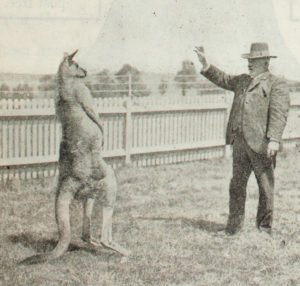Canterbury Park Racecourse
A summary mostly based on “They’re Racing at Canterbury by Lesley Muir, Brian Madden
And “The Essential Club – A history of Sydney Turf Club” by Gary Lester
Horseracing in Canterbury
Horseracing was popular in Canterbury from the early days of the Sugarworks village in the 1840s, when Cornelius Prout cleared part of his property for use as a racecourse [1]. Race meetings were organised regularly by the local publicans for the entertainment of their patrons, and the contests were frequently between their own horses [2].

After a lapse of some years, racing began again in 1871, when Frederick Clissold and Thomas Austen Davis organised a meeting on land leased by Davis in the vicinity of the present racecourse [3]. Of the 300 people who attended, most were local residents.
By 1884, the present site was leased from the Jeffrey’s estate as the headquarters of the Canterbury Park Race Club and gardens. A recreation park and a racetrack seven furlongs in circumference was laid out, and a grandstand capable of holding 700 people [5]. The directors of the race club were Frederick Clissold and William Lovel Davis.
The first meeting on Saturday 19 January 1884 was very successful, with an attendance of approximately 3,000 people [6]. Ordinary and special trains to Ashfield were crowded, and horse buses carried the visitors to the course [7]. In 1886, Davis visited Arthur Jeffreys’ son, John, who had inherited the land and who then lived in Salisbury, England, and purchased almost 53 acres at £200 per acre for the use of the Club [8].
A trainline comes to Canterbury
In 1878, a crowd of 3,000 attended a meeting to celebrate Queen Victoria’s Birthday [4]. As there was no satisfactory public transport to the course, most caught the train to Ashfield and walked from there. Some special coaches ran from Sydney, but the rough roads must have given passengers an uncomfortable ride. Add to that there was no way for horses to be transported to Canterbury Park and they often had to walk with their trainers. Many horses came from stables in Randwick to participate in the Canterbury races which is purported to have taken 2 hours to walk.
The need for better transport to these race events and strong lobbying from the Canterbury Park race holders and associated racing industries resulted in a decision to build a rail line from Marrickville which started in 1892 and opened in February 1895, horses could now finally be transported from Sydney in “horse boxes” and crowd numbers at Canterbury greatly increased.
Stables, blacksmiths, saddlers and harness makers
Many horse and pony trainers moved on to large blocks of land surrounding Canterbury, and by the 1890s there was quite a flourishing network, especially in Minter, Church, King, and Broughton streets, and over the river in Northcote Street. Remnants of some of these stables can still be seen, but many more have been demolished. For instance, the Andrew family’s stables in Church Street were sold to provide land to extend Canterbury Girls High School.
There were other related industries in the area: the Foord family ran the local blacksmith’s shop, while Edwin Crump, saddler and harness-maker, located his store in Canterbury Road near Unwin Street. Some of the shopkeepers made money on the side as illegal bookmakers.
Death and despair
On 6 May 1893, a jockey named Death was riding a horse called Despair when the horse fell in a hurdle race at Canterbury [9]. The Bulletin said that the combination was gruesome and they should be parted ! [10].
A recreational park and zoo!
For the first 11 years, the racecourse and park was looked after by George Monk, a gardener of great talent, whose specialty was growing pansies. He lived in the rustic gothic gatehouse which had been built for Canterbury House near Unwin Street. George’s son Jim took over as caretaker when he was 18 years of age, and held the job for sixty years until his retirement. Jim was in charge of a zoo that was on the racecourse until World War I and held kangaroos, wallabies, emus, brolgas, curlews, pheasants and kookaburras. Jim Monk recalled on one race day that a wallaby jumped from a tree onto the back of a woman, knocking her over as she was waiting to collect a bet. On another occasion, at a time when the public bar was in the open, a startled wallaby skidded along the top of the bar, knocking all the glasses to the ground.
Early aviators often landed on Canterbury park before Mascot airport was developed, One such aviator pair was Parer and Mackintosh who landed in Canterbury racecourse after traveling all the way from England competing in the great England to Australia air race. They must had got quite a shock landing in the middle of Canterbury park zoo filled with Kangaroos , wallabies, emu’s and the like!


The golden age
The 1920s and 1930s are often termed the “golden age of racing“ , as the beneficiaries of discretionary spending, thoroughbred racing enjoyed huge crowds, good turnover that coincided with the peacetime and a booming economy.
For a great many years, the racecourse gave a marked stimulus to the economic life of the Canterbury community and with the trainline to Canterbury in full operation and a new station complete in 1915, popular meetings recorded crowds in excess of 20,000 spectators !
However the coming of the economic depression would change all that.
Racing during the Great Depression.
Naturally this time took its toll on most businesses that relied on a worker having a spare couple of dollars to spend, The owners of Canterbury Park, the independent “Associated Racing Clubs” (ARC) relied on the more working class racegoer who were unfortunately the hardest hit by the times. It is safe to say the Great Depression had a decimating impact to ARC revenues and racecourse investors suffered, hoping for better times ahead, but it was not to be.



